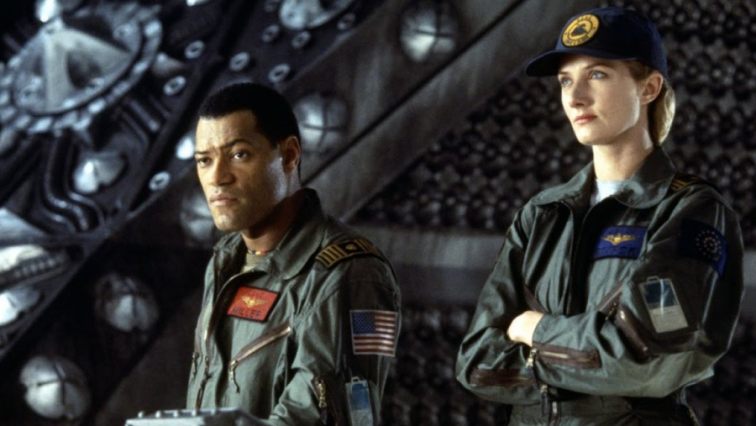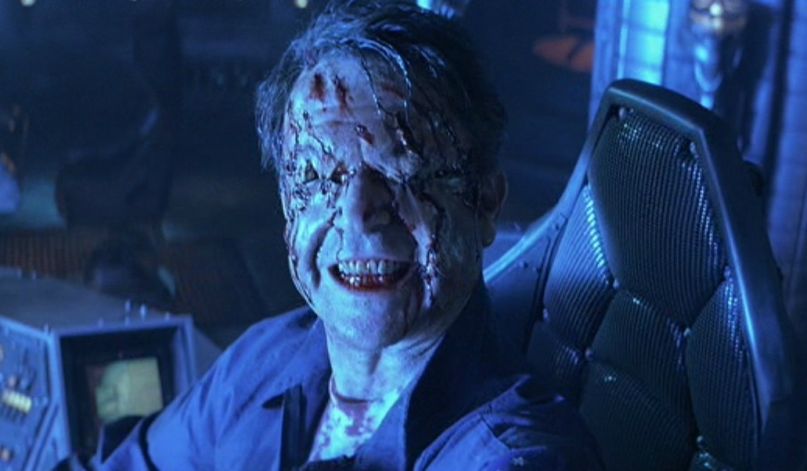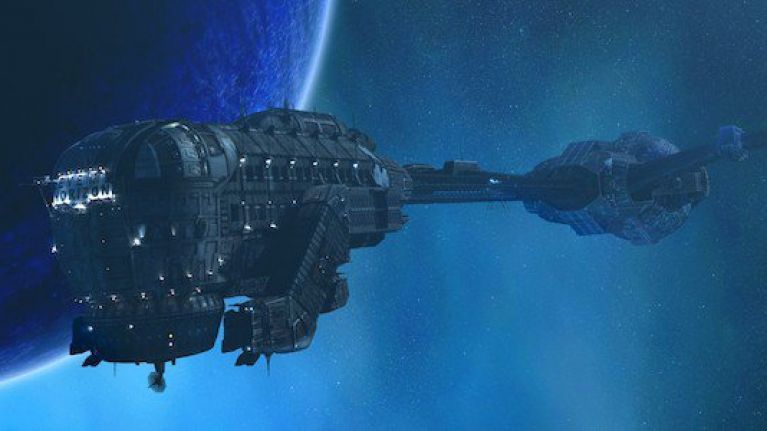“This place is a tomb.”
Space is terrifying. There’s no better summation of that unfeeling void than the tagline for Alien: In space, no one can hear you scream. It is close as we will get in our lifetimes to the infinite, to the indescribable. Like the deepest reaches of the sea, space is its own realm, one we were maybe not meant to explore. This is what makes films like Alien, Gravity, and Interstellar so effective and tense. While Event Horizon isn’t as polished as any of those films, it has enough atmosphere and creeping dread to recommend it. In its portrayal of a nightmarish realm worse than hell, one adjacent to ours, Event Horizon is the film that the insipid, sophomoric Hellraiser tried so hard to be.
The plot is straight out of Gothic horror. The titular exploratory vessel has been missing for seven years, only to now reappear in 2047, like a ghost ship. The Lewis & Clark is dispatched to investigate and possibly rescue crew members. The ship is captained by Miller (Laurence Fishburne), who is none too happy about the inclusion of Dr. William Weir (Sam Neill) on board. Weir built the gravity drive that powers the Event Horizon, so his presence makes sense, but he’s believable as an outsider. He never really interacts with anyone on board save for Miller, and in a nice, telling shot, we see the crew get into their assigned sleep tanks. They all know which one is theirs. Weir’s is designated by a piece of duct tape with his name written on it.
As ghost stories must go, the Event Horizon is derelict and abandoned. Debris floats through the air: a book, a watch, signs of life. (This is undermined somewhat by some truly dated CGI, but that’s not the film’s fault.) The design of the ship – and all of the ships in this film – owes a lot to the Nostromo and the Millennium Falcon in its workmanlike functionality. There is little thought given to aesthetics here, only purpose. The lo-fi sensibilities of the ship help sell the horrific aspects of the film, and director Paul Anderson (not the good one, the one who made all the Resident Evil films) uses the flickering lights and omnipresent shadow to disquieting effect.

The ship takes its toll on the characters almost immediately. Screenwriter Philip Eisner is careful to flesh out (most of) the crew, so we actually care when they start to get picked off in gruesome fashion. Fishburne is solid if a little one-note as Miller, until he gets a monologue that affords him some real vulnerability and dimensionality. Sean Pertwee (the best part of Gotham) is a standout as Smith; on paper, the character could be as anonymous as the name, but Pertwee is so naturally watchable that he makes an instant impression. Joely Richardson does solid work as Starck, and conveys capability and pragmatism. The only weak link, and it’s a major one, is Richard T. Jones in the role of Cooper. The film makes the misstep of acknowledging that Cooper’s role on the Lewis & Clark is vague, and Jones’ performance is so hacky and over the top that it threatens to derail the atmosphere of the film. He spouts nothing but one liners, no matter how dangerous or terrifying the circumstance, and Jones belts them all out with the smugness of someone who knows he’s going to be the breakout star. Cooper is a walking studio note, a character given nothing but tacky dialogue in an effort to introduce a bit of levity amidst all this macabre. Event Horizon would be far better without him.
It’s easy to look past Jones, though (well, most of the time) because of the back and forth between Neill and Fishburne. Sam Neill was in the midst of a terrific few years in the ’90s that also saw him in Jurassic Park and In the Mouth of Madness, and you can tell he relishes the chance to come close to camp. Weir and Miller have a testy chemistry that doesn’t quite cross over into antagonism, because they recognize elements of themselves in each other. They’re both just professionals who want to do things right.
Of course, the ship has other ideas. Eisner pitched Event Horizon as “The Shining in space,” and the comparison is apt. It’s unknown where the ship was for the last seven years, but we’re given enough to know it’s no place you want to be. The ship seems to have some kind of sentience (think The Haunting of Hill House) and it torments the crew with auditory and visual hallucinations. Weir sees his dead wife, eyeless; Miller sees a companion he let burn to death; and Peters (Kathleen Quinlan) sees the disabled son she left behind when she was ordered to go on this mission. Quinlan’s performance is fine, if not revelatory, but there is something about the way her face crumbles when she sees her son, Denny, that is genuinely heartbreaking.

Unlike Hellraiser – which Anderson cited as an influence – the gore in Event Horizon is effective, probably because the viscera we’re seeing splattered across the screen used to be inside characters we actually care about. The crescendo of insanity throughout puts the film firmly in the realm of Lovecraftian cosmic horror. Parts of it may be dated, and parts don’t work at all, but I admire Event Horizon for how it swings for the fences. (Anderson’s original cut was longer and rated NC-17; sadly, the original film stock deteriorated so we’ll never see what he took out.) When this thing works, it works. We get glimpses of whatever nether-realm the ship has visited, and it’s all scenes of torture and mutilation. Later we see horrifying footage of the ship’s original crew being murdered and assaulted by bloody demons.
Event Horizon is solid Gothic horror. When the ship turns Weir into its avatar, Neill turns in a villainous and genuinely scary performance that wouldn’t be out of place for a character in Poe or Lovecraft. Neill’s mellifluous voice wraps itself well around lines like “Hell is just a word. The reality is much, much worse.” Because of ratings constraints, there’s only so much that Event Horizon is able to show us – although it does show quite a bit! – but Neill sells the horror of what lies beyond the gateway.
This movie isn’t perfect. The effects are cheap even by the standards of the day, and the character of Cooper is unforgivable. But Event Horizon is still wildly entertaining and upsetting in equal measure. This is a bold film, and a worthy entrant into the Gothic horror canon. It’s bittersweet in a way, though. Where did this Paul Anderson go? Let’s hope he comes back.
10/1: Hellraiser / The Invitation
10/2: Splice / Banshee Chapter
10/3: Jennifer’s Body / Raw
10/4: Dominion: Prequel to The Exorcist / Book of Shadows: Blair Witch 2
10/5: Kill List / A Field in England
10/6: Halloween II / Halloween III: Season of the Witch
10/7: A Nightmare on Elm Street 2: Freddy’s Revenge / A Nightmare on Elm Street 3: Dream Warriors
10/8: Ginger Snaps / Creep
10/9: Cube / Creep 2
10/10: The Texas Chainsaw Massacre (2003) / The Ritual
10/11: Hell House LLC / The Taking of Deborah Logan
10/12: Re-Animator / From Beyond
10/13: Beetlejuice / Sleepy Hollow
10/14: Idle Hands / The Lords of Salem
10/15: The Ring / Noroi: The Curse
10/16: I Know What You Did Last Summer / The Monster
10/17: Night of the Living Dead / Train to Busan
10/18: The Devil’s Backbone / Southbound
10/19: Event Horizon / Dreamcatcher
10/20: The Cabinet of Dr. Caligari / The Bad Seed
10/21: Eyes Without a Face / Goodnight Mommy
10/22: The Strangers / The Strangers: Prey at Night
10/23: In the Mouth of Madness / The Void
10/24: The Amityville Horror / Honeymoon
10/25: Gerald’s Game / Emelie
10/26: The Monster Squad / Behind the Mask: The Rise of Leslie Vernon
10/27: Veronica / Jacob’s Ladder
10/28: High Tension / You’re Next
10/29: The Innkeepers / Bug
10/30: The People Under the Stairs / Vampires
10/31: Saw / Saw II

